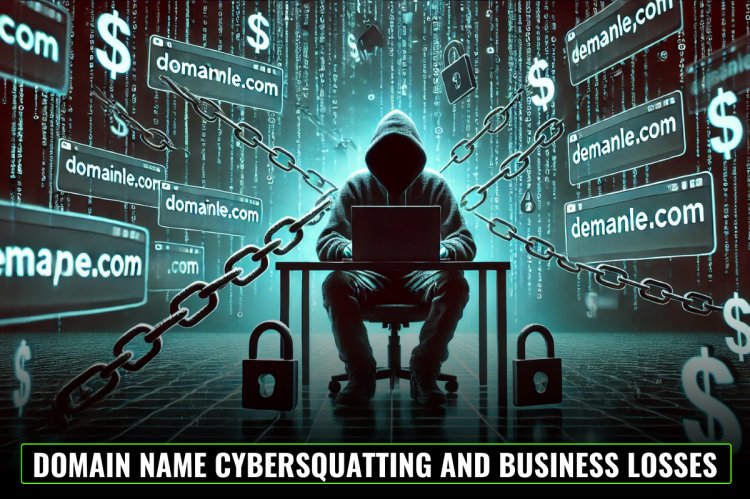Domain Name Cybersquatting and Business Losses
The digital economy has revolutionized business operations, making domain names critical brand assets. However, cybersquatting—the act of registering, selling, or using a domain name in bad faith—has posed significant threats to businesses. This blog explores the concept of cybersquatting, its legal framework, the financial and reputational damages it causes, and the measures businesses can take to protect themselves.

Introduction
With increasing digitalization, domain names have become vital identifiers for businesses, impacting brand recognition, customer trust, and online transactions. Unfortunately, cybersquatting has emerged as a major threat, leading to financial losses, reputational harm, and legal disputes. This blog aims to provide insights into cybersquatting, its impact on businesses, legal remedies, and preventive measures to combat this unethical practice.
Understanding Cybersquatting
Definition of Cybersquatting
Cybersquatting refers to the practice of registering, using, or selling a domain name in bad faith, often to exploit the goodwill of a trademark or brand name. Cybersquatters typically target well-known brands, personal names, and business identifiers to mislead customers, demand high resale prices, or divert traffic for fraudulent purposes.
Types of Cybersquatting
- Typo-squatting: Registering misspelled versions of well-known domain names (e.g., "gooogle.com").
- Brandjacking: Using a domain identical to a brand's name to deceive customers.
- Generic Squatting: Registering common words associated with an industry to sell them later at a premium.
- Reverse Cybersquatting: When a larger corporation falsely claims that a domain name was registered in bad faith to force its transfer.
Legal Framework for Cybersquatting in India
Lack of Specific Cybersquatting Laws in India
India does not have a specific cybersquatting law, but domain disputes are addressed through existing trademark laws, judicial precedents, and domain dispute resolution mechanisms. The Internet Corporation for Assigned Names and Numbers (ICANN) regulates domain names globally and has implemented the Uniform Domain-Name Dispute-Resolution Policy (UDRP) to handle disputes.
International and National Legal Approaches
1. UDRP (Uniform Domain-Name Dispute-Resolution Policy)
- Managed by ICANN to resolve international domain disputes.
- Allows companies to reclaim domain names without court intervention.
2. INDRP (IN Domain Dispute Resolution Policy)
- Managed by NIXI (National Internet Exchange of India) for .in domains.
- A complainant must prove that:
- The domain name is identical or confusingly similar to a registered trademark.
- The registrant has no legitimate interest in the domain name.
- The domain was registered in bad faith.
To know more about this you can follwo the link below:
Trademark Laws and Cybersquatting
The Trademark Act, 1999 provides indirect remedies against cybersquatting under trademark infringement and passing off. Section 29 prohibits the unauthorized use of a registered trademark that causes confusion or deception.
Notable Indian Court Cases on Cybersquatting:
- Rediff Communication Ltd v. Cyberbooth & Anr – The Bombay High Court ruled that 'Radiff' infringed upon the 'Rediff' trademark.
- Yahoo Inc. v. Akash Arora & Anr – The court held that using a deceptively similar domain name constituted passing off.
- Tata Sons Ltd v. Manu Kosuri & Ors – The Delhi High Court ruled in favor of Tata Sons against unauthorized domain registrations using the 'TATA' trademark.
- Sholay Media Entertainment v. Yogesh Patel & Ors – The court ruled in favor of protecting the film title 'Sholay' as a well-known trademark.
IT Act Provisions Against Cybersquatting
- Section 43 & Section 66 of the IT Act, 2000 address unauthorized access and damage caused by cybersquatting.
Business Losses Due to Cybersquatting
1. Financial Losses
- Loss of revenue due to misdirected traffic, counterfeit product sales, and ransom payments for domain recovery.
- High costs for litigation and UDRP/INDRP complaints.
2. Reputational Damage
- Erosion of customer trust due to fraudulent activities on counterfeit domains.
- Phishing attacks through fake domains leading to data breaches.
3. Competitive Disadvantage
- Redirection of customers to competitor websites.
- Negative impact on SEO rankings and brand exclusivity.
Preventive Measures Against Cybersquatting
1. Defensive Domain Registration
- Register multiple variations of the brand name across different domain extensions (.com, .net, .org, .in).
2. Trademark Registration
- Strong trademark protection strengthens legal claims against cybersquatters.
3. Monitoring and Enforcement
- Use tools like Google Alerts, DomainTools, and MarkMonitor to detect unauthorized domain registrations.
4. Legal Action and Dispute Resolution
- File UDRP or INDRP complaints for domain recovery.
- Pursue litigation or arbitration against cybersquatters.
Conclusion
Cybersquatting continues to be a serious challenge for businesses, leading to financial, reputational, and market-related damages. While legal frameworks like INDRP, UDRP, and Trademark laws provide recourse, businesses must adopt proactive measures such as defensive domain registration, trademark protection, and continuous monitoring to safeguard their online identity and brand equity. In an era of evolving digital threats, vigilance and strategic planning are crucial to mitigating the risks of cybersquatting.












